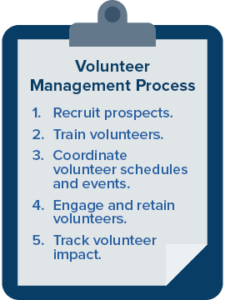Free ROI Resource for Volunteer Programs
Some of our community’s most impactful initiatives rely on volunteers, and it’s Volunteer Managers leading the charge in organizing these programs. Managing volunteers is a balancing act of time and resources. And between recruiting, scheduling, and engaging supporters, little time is often left for much else, like keeping up with volunteer management best practices.
But updating your volunteer management strategy is essential to your program’s growth. So, we’ve compiled these ten fresh best practices for the modern volunteer program (no stale tips or tricks, here!).
Article Contents:

Before we jump into our top volunteer management best practices, here’s a refresher on need-to-know basics:

What Does Volunteer Management Consist Of?
Volunteer management encompasses the steps, actions, and tools you’ll need to:
- Recruit prospects
- Train volunteers
- Coordinate volunteer schedules and events
- Engage and retain volunteers
- Track volunteer impact
FREE DOWNLOAD: Volunteer Program ROI Guide

Successful volunteer management takes careful planning, and any organization with a volunteer program can benefit from implementing a volunteer management strategy. When volunteers are managed effectively, organizations build capacity and even improve return on investment.

What Is the Role of the Volunteer Manager?
Volunteer Managers wear many hats, and they’re often involved in all steps of the volunteer management process. In addition to overseeing the selection, training, and supervision of volunteers, Volunteer Managers may also be responsible for:
- Developing volunteer opportunities based on the community’s needs
- Matching volunteers to these opportunities based on their skills and interests
- Seeking and maintaining key partnerships with local corporations and organizations

What Makes a Good Volunteer Manager?
Dynamic Volunteer Managers possess a diverse set of skills. Much of the role relies on relationship building, so Volunteer Managers should feel comfortable interacting with people regularly and asking for help! They should also have:
- Strong time-management and organizational skills
- Keen communication and interpersonal skills
- Leadership experience
- Volunteering experience!

Another requirement of the job? Passion! Volunteer professionals are passionate about helping others and bettering their communities. It’s what inspires volunteers to engage with the cause continuously.
Keep reading for expert volunteer management best practices that help Volunteer Managers (like you!) succeed in their roles.

We’ve compiled the top volunteer management best practices for the modern volunteer program; it’s all about working smarter (not harder) to get better results. Investing in these recommended tools and strategies today will save you time and resources in the long run.

1. Use a Comprehensive Volunteer Management Platform
Today, adopting volunteer management software is considered best practice. Busy Volunteer Managers need dependable, cost-effective technology that streamlines and simplifies administrative processes. In other words, countless spreadsheets and paper documentation are both costly and cumbersome.
Download the free Volunteer Program ROI Guide!
Innovative volunteer programs rely on a dedicated volunteer management system to digitize and automate daily volunteer management activities. Some of the most helpful software capabilities include:
- Simplifying registration and streamlining volunteer data
- Easy volunteer opportunity scheduling
- Matching volunteers with opportunities based on skills and interests
- Simplifying check-in with a mobile app
- Tracking volunteer hours and reporting on program impact
- Automating communications with email and text messaging
- Promoting volunteer events and opportunities
Powerful volunteer management software centralizes a range of tools needed to successfully and efficiently manage volunteers.
Why do you need volunteer management software?
When administrative tasks are automated and streamlined, Volunteer Managers have more time to focus on highly impactful activities like engaging volunteers and maintaining essential partnerships.

Volunteer Management Software Tips
Looking into volunteer management software? Keep your most important needs in mind when making a decision. Consider the following for a seamless transition to your new software:
- Identify your key volunteer management features. Compile a list of your must-have features, and note the capabilities and tools you’re missing from your current management system. From volunteer recruitment to reporting, you need a dynamic system that grows with your program.
- Do your research. Once you have a clear sense of the capabilities you’re looking for, take some time to look into the best volunteer management software options available–there’s a system for volunteer programs of every size and shape! (And don’t forget to take closer look with free software demonstrations).
- Look for easy integration. Your volunteer management software should easily integrate with your organization’s existing website. You’ll also want to ask about the software’s reporting integration with your existing data collection tools.
- Opt for user-friendly. You want volunteers to get the most out of your investment. But if the software is antiquated or too tricky to navigate, it’s probably not going to entice your volunteers and staff to use it. Fortunately, volunteer management software can be both powerful and user-friendly.

2. Define Goals and Measure Success
Whether you’re starting a volunteer program or evaluating your current one, goal setting is essential to any volunteer management strategy.
When defining your volunteer program goals, think SMART. Your SMART goals should be:
- Specific – Are your goals focused? Avoid vague, overly general statements
- Measurable – Can you quantify program outcomes? Create goals that are trackable over time.
- Attainable – Can you achieve these goals with your current available resources? Your objectives can be ambitious but should also be realistic based on your capacity.
- Relevant – Do your goals align with your program’s mission? Your goals should lead to valuable outcomes for those you serve.
- Time-Based – What is your timeline for measuring these goals? Setting a deadline will help you develop a clear plan and motivate staff and volunteers.
Once you’ve defined your program objectives, identify staff and volunteer actions required to accomplish the intended outcomes. You’ll also want to establish indicators of success and strategies to measure goal attainment.
The following example illustrates one method in which goal-setting can lead to an actionable plan with measurable outcomes:
Goal:
- Support at-risk students to better prepare them for further education.
Activities:
- Identify at-risk students
- Train volunteers to provide academic support and guidance
- Volunteer meets with assigned student once per week
Indicators of Success:
- Improvement in student’s grades
- Increase in student attendance
- Student demonstrates improvement in academic and social confidence
Methods of Measurement:
- Track changes in report card throughout the academic year
- Collect attendance data from school
- Collect observations on student behavior
- Collect assessment from guidance counselor and student

3. Focus on the Volunteer Experience
Volunteer programs should prioritize their volunteers; it seems like a no-brainer, right? While you depend on your volunteers to deliver critical services, tight budgets and busy schedules sometimes mean that volunteers don’t get the attention they deserve.
When volunteers feel neglected, you’re more likely to see diminishing satisfaction, decreased performance, and higher turnover rates. Volunteers are the key to program success; therefore you’ll need to keep them at the forefront of your mission.
So, how can you prioritize your volunteers?
Keep your volunteers happy and engaged by creating a positive volunteer experience.
Volunteers tend to be most satisfied with their work when they:
- Enjoy their first volunteering experience
- Feel connected to your core mission
- Are prepared for the volunteer work
- Create meaningful personal relationships while volunteering
- Understand how their work is directly impacting the community
- Feel appreciated
Now that we know what volunteers are looking for, here’s what you need to do to create meaningful, positive volunteering experiences:
Focus on first impressions.
Your volunteers’ first interactions with your organization should be positive (read: frustration-free). Welcome new volunteers with a personalized email, streamline your onboarding process, and simplify onsite check-in.
Collect key data on volunteer preferences and skills.
Today’s volunteers are looking for personalized experiences. Give volunteers a simple way to share their interests, skills, and qualifications upon registration. This behind-the-scenes data collection should inform volunteer matching, so you can more readily pair volunteers with impactful opportunities they’ll love.
Survey volunteers.
Empower your supporters to help shape your program. Survey volunteers about their experience, feedback, and ideas. Most importantly, use volunteer feedback to inform decision-making.
Share impact data.
Show volunteers that their contributions are making a real difference. Regularly track and report on your volunteers’ hours and impact data. A volunteer management system automates the hours collection process and can even produce live-updating reports specific to each volunteer or volunteer group.

4. Empower Volunteers to Promote Your Message with Social Sharing
According to volunteer management best practice, social media should become a core element of your program’s marketing strategy. More specifically, the future of marketing is peer-to-peer (you’ve probably heard of peer-to-peer fundraising). Peer-to-peer marketing is cost-effective and powerful, and most easily achieved through social media.
So how does it work? When your supporters share content about your organization on social media, they’re incidentally promoting your cause. In other words, your current volunteers are your best advocates. People are more likely to trust the recommendations of friends, family, and colleagues over other forms of outreach. This is a great way to encourage your supporters to invite their peers to join and volunteer, too!
The takeaway? Empower volunteers to share your message, and watch your network grow!
Here’s how to get your content shared:
- Attach sharing buttons to your web content – Make it easy to share your content, from volunteer opportunities to event announcements. Sharing buttons should link to social platforms like Facebook, LinkedIn, and Twitter.
- Learn from other viral marketing campaigns – You can learn a lot from other successful nonprofit marketing campaigns like these. While most campaigns won’t achieve viral success overnight, you can put these practices in place to reach a larger audience more quickly.
- Drive new engagement – Generally, the more people you can reach on social media, the better. The best way to grow your audience is by posting a variety of relevant and engaging content on multiple social platforms. You should use your social media channels to share fundraising content and calls for volunteers. But if you’re only asking for support on social media, followers begin to lose interest. Instead, share other relevant and engaging content like videos and inspiring messages. You’ll drive new engagement when your supporters re-share content that resonates with them.
- Follow with a call-to-action – Your supporters are more likely to share your content when they’re asked. Whenever you post on social media or send your newsletter, create a call-to-action to share your content. Your message can be as simple as, “Share this event with your friends!” Don’t forget to attach those social sharing buttons.

5. Employ a Multi-Channel Volunteer Recruitment Strategy
Strategic volunteer recruitment is an essential volunteer management practice; without it, you’ll struggle to get the volunteers you need.
Most volunteer programs are dedicating time to actively recruiting new volunteers. However, many aren’t maximizing their recruitment efforts.
So, what is the best way to recruit more volunteers?
Utilize multiple channels to reach prospective volunteers. To recruit more volunteers, take advantage of various media and platforms, including:
- Your organization’s website – Start by making volunteer opportunities easy to find on your website. Dedicate a main menu item and web page to volunteerism. Include calls to action like “Get Involved” and link to your volunteer management platform.
- Social media – Take to social media platforms like Facebook, Twitter, LinkedIn, and Instagram to promote events and volunteer programming. With every post, include a direct link to your volunteer site.
- Email – Email is one of the most effective ways to market your volunteer program. Employ email marketing tactics. Invite website visitors to sign up for your newsletter and email recipients with a personalized list of opportunities (volunteer management software automates this process, saving you hours on building custom email lists).
- Larger volunteer opportunity platforms – If you’re partnered with your state, city, or another community partner, take advantage of their volunteer opportunity platforms! Create a content partnership and share opportunities and content between platforms (you’ll each benefit from new networks).
- In-person and virtual recruitment events – Don’t underestimate the power of face time. Recruitment events create valuable networking opportunities. They give volunteers the chance to engage with your cause, learn more, and ask questions. Look out for volunteer fairs and events hosted by your community center, local university, or business. Or, plan your own! Don’t forget to spread the word on the channels listed above!
Download the free Volunteer Program ROI Guide!

6. Adopt a Dependable Communication System
Volunteer programs need reliable communication to function efficiently. Without the right tools, keeping your volunteers informed becomes a difficult and time-consuming process. Fortunately, today’s technology simplifies and expedites communication.
To get the most bang for your buck, we recommend opting for a multi-tasking volunteer management software that integrates communication systems with other management functionality. If you manage both your volunteer and donorship programs, you may also opt for CRM.
A professional communication system can:
- Schedule emails in advance. Marketing professionals create email schedules to ensure their message reaches their audience at the best times. Volunteer Managers can use the same email marketing functions to send reminders, promotional material, and newsletters.
- Segment email lists. Bulk emails can be useful. But sending everyone in your contact list the same email? That’s when emails start to feel spammy, a surefire way to deter recipients. Instead, ensure that most of your emails are targeted to a specific, strategic audience. Your communication tool’s email segmentation feature simplifies building email lists, so your audiences receive relevant messaging.
- Automate communications based on volunteer actions. The system will automatically trigger thank-you emails, welcome and registration emails, reminder text messages, and other notifications when a user performs a task on your site (such as registering for a volunteer opportunity or logging their volunteer hours).
- Send mobile updates. Take advantage of increasing mobile phone usage by sending texts and automated reminders to your volunteers’ mobile phones. They’ll need to opt-in first, but texts are great for on-the-ground communication and management. Some communication systems even offer free volunteer mobile apps that automatically send reminders and alerts.

7. Track Volunteer Engagement
Did you know that 62% of service-focused organizations are losing valuable volunteer data due to poor record-keeping? While every volunteer program should track volunteer impact, not every organization has a system to keep data organized.
Simply put, good data empowers organizations to win grants, inspire support, and build capacity. That’s why volunteer programs benefit from investing in better data tracking.
An automated tracking system collects and stores volunteer hours and other impact data for easier reporting. If you’re looking to upgrade from spreadsheets and manual data entry (talk about time-consuming!), here’s what to look for in an automated hours tracking system:
- Multiple tracking tools for easy data collection – If you want your volunteers to log their data, you need to make it easy for them. Even better, an automated tracking system increases data accuracy. From web-based hours logs to mobile apps, flexible tracking leads to better data.
- Segmented reporting – Find the information you need by segmenting reports based on a range of data, such as volunteer projects, events, volunteer groups, and more.
- Compelling visual reports – Inspire stakeholders with visually interesting reports. Look for a system that allows you to download and export reports for easy sharing with volunteers, community partners, and your board.


8. Cater to Volunteer Groups
Does your organization welcome families, corporate partners, student groups, and volunteer teams? Our communities benefit when we volunteer together. In fact, studies show that volunteering with others makes people happier. And your volunteer program wins too–more helping hands means greater impact! So, why not tap into your volunteers’ networks by making it easy for volunteer teams to get involved?
Need to measure your program's ROI? Get the free resource >>
But here’s the catch: managing volunteer groups isn’t always straightforward. You have lots of members to connect with, and many teams want to know their collective impact. Without a strategy in place for engaging volunteer groups, Volunteer Managers miss out on fruitful partnerships.
The best way to cater to volunteer groups is to assess your current volunteer management system. When it comes to engaging teams of volunteers, make sure your management tools have the following capabilities:
- Group sign-up – This feels like a no-brainer, but not all management systems enable team registration, so make sure your system live-updates available shift openings and allows a group leader or member to hold multiple shift spots.
- Personalize communications – Communicating with larger groups can get tricky. Allow teams to assign leaders or a point-person for simpler communication. Volunteer Managers should also easily segment and message group members for efficient, more personalized team communication.
- Provide exclusive access to opportunities – Great for engaging corporate partnerships and school groups, create branded pages for private access to a tailored list of opportunities and collective participation data.
- Track and report on collective team impact – Most of your volunteer groups probably want to know their collective contributions (even if they volunteered for different opportunities!). Adopt a system for tracking group volunteer impact. Each member should be able to view and download a team impact report.
With the right tools, you’ll grow your volunteer program without fearing those large groups!
Join 20,000+ Volunteer Leaders
Sign up for our Newsletter - Get fresh articles, guides, and webinars to help grow your volunteer program delivered to your inbox.
"The best free resources available for Volunteer Managers!" - Beth P.

9. Provide Volunteer Orientation and Training
Volunteer training provides volunteers with the knowledge and resources to complete work independently and effectively, empowering them to have a measurable impact in your community. Plus, volunteer training is associated with higher performance and long-term involvement.
Make volunteer orientation and training a core component of your management strategy, and enjoy the benefits of prepared, engaged volunteers.
Level up your orientation and training program with these best practices:
Welcome new volunteers with an orientation.
Before you jump right into any role-specific training, take a moment to welcome new volunteers. The primary purpose of volunteer orientation is to acquaint recruits with your organization, staff, processes, and mission.
Your orientation should also provide context and purpose, give a brief history of your organization, help newcomers understand the complexities of the needs and gaps you’re addressing, and introduce client profiles where appropriate.
You may choose to deliver this information entirely online, in-person, or a combination of both. Visit this article for more tips on how to set your volunteers up for success.
Plan your volunteer training content.
Before you implement your training program, formulate a content plan; what do you want volunteers to learn? How extensive will your training be?
Basic training usually covers the following information:
- How to communicate the organization’s mission
- Goals for the activity and evaluation methods
- How to perform the volunteer task
- Safety measures
- Rules of volunteering with your organization
- Overview of equipment and how to use it
- How to submit volunteer time
Support your training with technology.
Introducing technology into your training program will help volunteers get acquainted with the systems you use and keep them engaged in the material.
Here are some ways to embrace technology in your training:
- Webinars – Host live virtual volunteer training sessions for at-home training. Tools: Zoom
- Videos – Create engaging pre-recorded videos to help aid training. Tools: Animoto, Vimeo, Youtube
- Interactive e-Learning – Create online training that includes slides and other clickable elements. Tools: PowerPoint, Prezi
- Online quizzes – Test your volunteers’ knowledge with fun, low-stakes quizzes. Tools: SurveyMonkey, Google Forms.
Go virtual.
Meet your virtual volunteers where they are: online! Online volunteer training is cost-effective and allows busy volunteers to learn in their own time.
Virtual training offers flexibility so that eager volunteers can get started in their own time. Integrate virtual training elements into your onboarding process for a seamless transition. So, once a volunteer registers, promptly provide them with instructions on how to access virtual training.
For more skilled volunteer roles, virtual volunteer training tends to work best when accompanied by a brief in-person session–you’ll be able to answer questions as they arise naturally and engage in more meaningful conversation face-to-face. Furthermore, some role-specific training is best carried out in person (like CPR training).
>>> Read our comprehensive guide on volunteer training.

10. Recognize Your Volunteers
Are you investing enough time into thanking and recognizing your volunteers?
Over 40% of public charities rely heavily or entirely on volunteers to operate, and Americans volunteer 8.8 billion hours annually. Without their contributions, communities would not have access to some of the most fundamental public programs and services. In other words, all volunteers deserve regular, genuine demonstrations of appreciation.
Need to measure your program's ROI? Get the free resource >>
Recognize your supporters with these tried and tested volunteer appreciation ideas:
- Rethink your gift-giving – Branded swag is great, but unique, thoughtful gifts are better. Invite clients to create handmade cards, compile a community cookbook, source consumables from a local favorite. These gifts are inexpensive, but the personal touch feels special.
- Invest in your volunteers – Give back to your volunteers by investing in their lives. Offer to write a recommendation letter to help a young volunteer secure their dream school. Give enthusiastic forward-thinkers a voice by offering them a leadership role. Help students and pre-professionals boost their resumes and practice professional skills. Invite retired volunteers to demonstrate their expertise or mentor others.
- Recognize volunteer impact – Even the most selfless volunteers want to know that their efforts make a real difference. Acknowledge and celebrate volunteer achievements. Track each volunteers’ hours and celebrate milestones. Recognize committed volunteers with a “volunteer of the month” feature. Tell your volunteers’ stories and how their contributions are significant to your community. Good deeds are contagious, and your volunteers’ stories are sure to inspire others.
- Thank them often – Thank your volunteers after each shift and throughout the year. Simply saying–or writing–”thank you” goes a long way in making volunteers feel appreciated.






